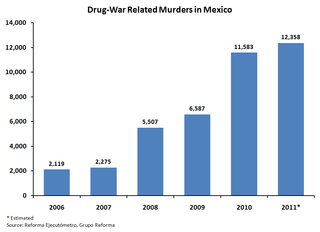
Mexico represents an unrivaled opportunity for economic growth and security for the American people. The US can continue a half-baked policy of treating Mexico like any other foreign country or it can take advantage of one of the greatest opportunities in our history to make a fresh Mexico policy based on our unique relationship with our only neighbor outside of Canada. The following plan, would boost the American economy’s potential growth. It is an opportunity for America to invest and reap, in my honest opinion, multi-trillion dollar returns. If the US government makes several changes to its domestic and foreign policy, the effects could help unleash the massive economic potential of the 112 million customers in the democracy to our south and in doing so create a stronger United States.

A continuation of current US policy will not likely prevent Mexico’s rise but taking advantage of the opportunity to help turn Mexico into an economic success story on par with the massive growth of modern China may be missed. Already Mexico has roughly a 1.1 trillion dollar per year GDP and is predicted to be among the ten largest economies in the world by 2020. Abundant natural resources, close access to the US market and political stability make Mexico a natural trading partner. According to the New York Times article, Mexico: the Next China, “what all these pieces add up to is a model — one that might hold the long-sought answer for how American manufacturers can compete with those in China, India and the next generation of economic powerhouses.”
There is clearly more room for Mexico to grow if the United States can make some difficult decisions to support our neighbor. For comparison, America’s only other neighbor Canada has a 1.74 trillion dollar economy compared with Mexico’s 1.1 trillion. But Canada only 35 million people and Mexico has 112 million. The reason these numbers don’t add up is that where the US and Canada are among the richest countries by GDP per capita, Mexico ranks 56th between Libya and Malaysia according to the World Bank.
The United States relationship with Canada is among the most amicable and mutually beneficial in the world. Skipping over the issue of who caused Mexico’s trouble, helping Mexico bridge this yawning gap and enter the top ranks is in the interest of Canada and the US.
The pie graph shown here of the top US export markets reveals a basic truth of economics: When it comes to trading partners in the modern world economy: location, location, location. Who does New York sell to most? New Jersey. Who does the US sell to most? China has the world’s largest population of 1.344 billion people. Yet, Canada continues to be the top country for US exports despite having such a small population compared with the likes of China that small potential errors in the Chinese population count may add or subtract an entire Canada’s worth of population to the true number.
The simple underlying fact here is that neighbor Mexico is over three times bigger than Canada in population and represents a much larger potential market for US goods and services. What is needed is a Mexican Marshal Plan. Invest in Western Europe’s destroyed cities after World War II and build markets for U.S. exports. Invest in Mexico in the 21st century to build markets for U.S. exports now.

The Solution: For good.
There are three major American policy areas where new thinking could rearrange relations between our two countries: smuggling, immigration, and investment.
Policy Change Number One: Smuggling
Mexico has been under the assault of smuggling gangs serving the American black market consumer for too long. Dead Mexican police officers, judges and politicians combine with corrupt officials taking bribes from the multi-billion dollar drug smuggling cartels to wreak havoc on large areas of Mexico. Yet, American policy makers must realize that not one of the cartels threatening Mexico could survive if the US took up real drug policy reform.
When Prohibition added alcohol to the inventories of smugglers in 1920, the US was ravaged by the increasing power of black market smuggling gangs like Chicago’s Al Capone. In the 1933 repeal of alcohol Prohibition, the US Congress ended the violent reign of alcohol smuggling cartels and brought much needed tax revenue. Today, the same pattern can be true for modern smuggling gangs if their marijuana business is regulated and taxed.
The UN estimates that marijuana legalization efforts already in place in California and Colorado cost the smuggling gangs 20-30 percent of their revenue. Some form of decriminalization of marijuana and new policies for non-violent ‘criminals’ in justice system would lead to the near destruction of the black market in the US.
There are plenty of domestic reasons for America to decriminalize marijuana which is why over half of Americans support decriminalization, but the foreign policy implications are massive. The black market is estimated to worth $31 trillion worldwide and smuggling marijuana to the US is a massive slice of this bounty. From Colombia’s violent history to the power of smuggling gangs in Central America, there is a large slice of the Americas that is ravaged by the drug war.

Even in Afghanistan, the Taliban insurgency funds their war by taxing black market marijuana as much as heroin. US drug war policy changes are good for America, for Mexico, and for the world.
Policy Change Number Two: Immigration
There is deep opposition to immigration in the United States and this cannot be ignored. But I will go ahead and argue that Mexico and Canada are simply the only two situations that will always play a unique role in American immigration. In a dangerous world of 196 countries, actual terrorists intent on smuggling things into our country, and good old war, famine and pestilence, Mexico is a strength, not a weakness, for the entire continent of North America. Compare our situation and our two neighbors with that of China whose land border neighbors include North Korea, Russia, Mongolia, Kazakhstan, Kyrgyzstan, Tajikistan, Afghanistan, Pakistan, India, Nepal, Bhutan, Myanmar, Laos, and Vietnam.
As recent news reports show, more Mexicans left the US for Mexico last year then came to the US. First, legalize the eleven million undocumented citizens-to-be already living with us. Second, the US needs to take advantage of this unique turning point and make ‘immigration reform’ a thing of the past. A permanent solution needs to be found based on an immigration policy with Mexico’s needs in mind. If Mexican immigration increases back to large numbers again, we must be more welcoming. A border of razor wire and military drones does not make good neighbors. Even if immigration from the rest of the world needs to be curtailed for short periods of time, we must accommodate Mexico’s needs as our own.
Policy Change Number Three: Investment
Mexico has a two-thousand mile border with the U.S. and yet total non-military aid to Mexico is less than Americans spent in theaters on the latest Twilight sequel. Beyond private investment, which already is substantial, the US should afford a good portion of its foreign aid budget to Mexico. A Marshall Plan style investment of a tiny portion of our federal budget could be instrumental in building long-term strength in the Mexican economy and a permanent friendship.
The Marshall Plan cost $13 billion dollars, equivalent to around $100 billion in 2010 value (see link below). A fraction of that cost spent wisely in Mexican education, infrastructure and poverty reduction could, like the Marshall Plan itself, build new customers for American business, cement our critical foreign alliances and offer a lifeline to the parts of Mexico that are worst affected by poverty. In addition, fighting poverty in the hardest hit areas of Mexico is a direct pathway to reducing surges in immigration.

Infrastructure aid to Mexico particularly is literally an investment in extending our own network of highways, railroads and energy infrastructure south, perhaps even as far as Central America and beyond. Even during our own time of economic stagnation, we must take advantage of the size of our sixteen trillion dollar GDP and make investments in our future. The US needs to set large goals for ourselves; it is customary in our history. But instead of investing in far-off countries we have just bombed into the Stone Age, what about investing here in North America with that same checkbook in an act of peace?
Friend in Mexico Conclusion
Mexico is the most populous Spanish speaking country in the world with the beautiful remnants of the Olmec, Aztec and Mayan civilizations among many others. Mexico ranks sixth in the world and first in the Americas by number of UNESCO World Heritage Sites with 31 and is the tenth most visited country in the world with 21.4 million international arrivals per year (see link below) Mexican cuisine is world famous and Mexico is the origin of mariachi music and the birthplace of chocolate, yes chocolate. We are lucky in our neighbors. The time is now for a renewed push to mend our relationship with Mexico. Acting in unison with Canada, the chance for the US to be a contributor to an economic miracle for the Mexican people and for North America is within our grasp and our own vital self-interest.
References:
- Schain, Martin. The Marshall Plan: Fifty Years after. New York: Palgrave, 2001. 1-3. Google Books. Web. 28 April 2010.
- “UNESCO World Heritage Centre – World Heritage List”. UNESCO. Retrieved May 25, 2012.
David Anderson says
Excellent article. The utter refurbishment of our insane drug laws has to be first item on the list – it emiserates and impoverishes millions of Mexicans (and Americans) and is the fuel that their corruption machine runs on. Its crazy, unkind and unprofitable.
Also…. Trump’s populist scapegoating of Mexicans here in the US appeals to his base – remember conservatives place a high value on “righteous (sic) punishment” – he/they NEED somebody to pick on, bully and torment. Additionally, the wall concept, that idiot wall, is another psychological aspect of conservatives who “sacredize” (not a word, I know, but you get it), make sacred borders as a Thing, more than just a division of jurisdictions. Plus there’s the in-group out-group dynamic conservatives love to treasure. That’s it for today from your armchair psychiatrist. :-)
Your economic arguments make a lot of sense. Great article. Except for the mariachis, we really need fewer of them. ;-)
David NYC